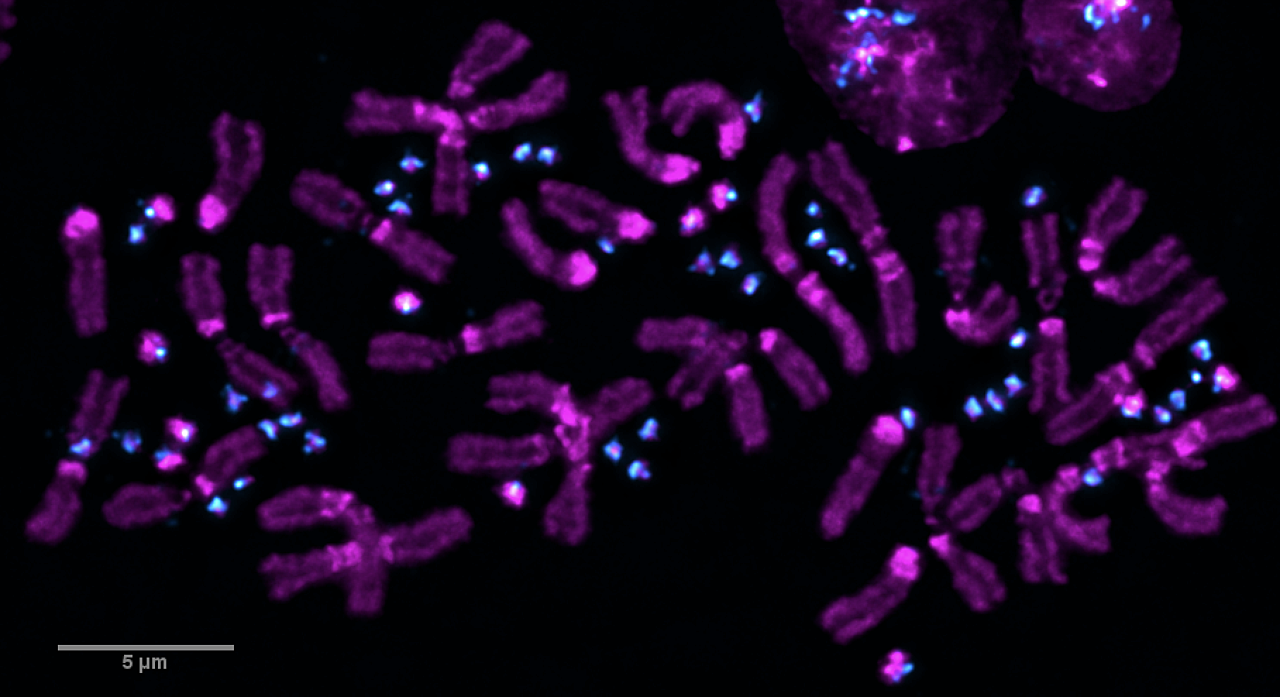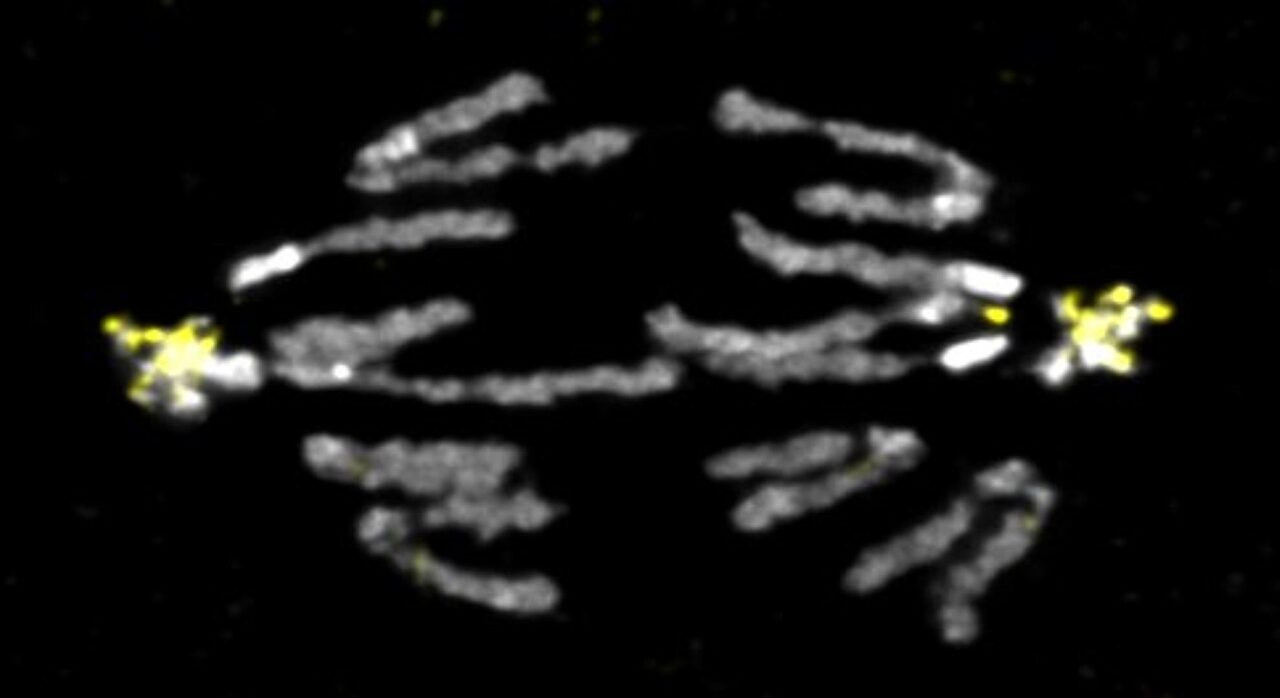News
15 April 2025
Light sheet microscopy: A decade-long journey from DIY innovation to cutting-edge imaging
A look at the technology that provides researchers with deeper insights into complex biological systems.
Read Article
Press Release
Offers unique opportunity to study similar chromosomes linked to cancer and infertility in humans
Researchers discuss their new findings and the impact of the work
KANSAS CITY, MO—May 4, 2023—Most chromosomes have been around for millions of years. Now, researchers from the Stowers Institute for Medical Research have revealed the dynamics of a new, very young chromosome in fruit flies that is similar to chromosomes that arise in humans and is associated with treatment-resistant cancer and infertility. The findings may one day lead to developing more targeted therapies for treating these conditions.
A new study published in Current Biology on May 4, 2023, reveals how this small chromosome that arose less than 20 years ago has persisted in a single, lab-reared strain of the fruit fly, Drosophila melanogaster, and is correlated with supernumerary (extra) chromosomes in humans.
“I feel kind of like an astronomer who’s watching the birth of a star,” said Stowers Investigator Scott Hawley, Ph.D. “We are getting to watch the birth of a chromosome and are starting to understand both its capabilities and limitations.”

Paired chromosomes during meiosis. Essential A chromosomes are in magenta and B chromosomes are cyan.
Previous research from the Hawley Lab had first identified these small, extra chromosomes, but little was known about their form, function, or dynamics during cell division. Former Hawley Lab Postdoctoral Researcher Stacey Hanlon, Ph.D., realized that this discovery could be an ideal system to investigate how new chromosomes arise, which may lead to more effective cancer treatments and methods to overcome infertility.
Supernumerary chromosomes in humans are found in cancer cells and frequently interfere with drugs designed to target tumors, making these types of cancers, like osteosarcoma, difficult to treat. In addition, the presence of supernumerary chromosomes in men can disrupt normal chromosome segregation during sperm production, which can cause infertility.
“Being able to understand how supernumerary chromosomes arise and what their structures are can potentially illuminate their vulnerabilities,” said Hawley. “This may enable the development of potential therapeutic targets.”
Called B chromosomes—as opposed to the standard “A” set of essential chromosomes—these genetic elements naturally appeared in a single laboratory stock of fruit flies in Hawley’s lab. Now, the researchers are witnessing chromosome birth and evolution in less than two decades.

Chromosomes in anaphase (left) and metaphase (right) from larval brain tissue. Larva has 13 B chromosomes in addition to eight essential A chromosomes. DNA is stained with DAPI.
How does something like this new chromosome apparently arise from nothing? More important, as these newly born B chromosomes do not possess any known essential genes for fruit fly function, how do they persist in a genome? In short, by cheating.
“I like to call these B chromosomes genetic renegades,” said Hanlon. “They do not follow the rules.”
Hanlon discovered that the fruit fly B chromosomes are maintained by a mechanism called “meiotic drive” that enables the them to rebel against the usual rules of inheritance. The B chromosomes drive their way into the next generation during the formation of the egg to ensure their own persistence in more than half of the next generation.
“Their genetic background—meaning the unique features in the B chromosome flies’ genetic make-up—supports their preferential transmission to the next generation,” said Hanlon. “That buys these guys evolutionary time to become a new chromosome, whether that’s picking up an essential gene or acquiring something that enables them to better cheat.”
Importantly, meiotic drive is a powerful force that can shape how genomes evolve. These findings originating in the Hawley Lab and actively investigated by Hanlon, now in her own lab at the University of Connecticut, can be used to understand the mechanisms behind what keeps meiosis fair and ensures that cheaters, like the B chromosomes, do not prosper. Additionally, Hanlon is examining how specific mutations can lead to chromosome breakage and new chromosome formation, revealing the mechanism of how supernumeraries arise and become requisite components of a genome.

Chromosomes in anaphase with B chromosomes and Chromosome 4 highlighted in yellow using a special sequence recognition probe.
“We’re always looking for Achilles heels to get rid of these kinds of things,” said Hawley of problematic supernumeraries in humans. “If we can identify what encouraged their formation, we may be able to identify individuals more likely to form them and take better measures to look for and deal with them.”
This work was funded by the Eunice Kennedy Shriver National Institute of Child Health and Human Development (award K99/R00HD099276) of the National Institutes of Health (NIH) and by institutional support from the Stowers Institute for Medical Research. The content is solely the responsibility of the authors and does not necessarily represent the official views of the NIH.
About the Stowers Institute for Medical Research
Founded in 1994 through the generosity of Jim Stowers, founder of American Century Investments, and his wife, Virginia, the Stowers Institute for Medical Research is a non-profit, biomedical research organization with a focus on foundational research. Its mission is to expand our understanding of the secrets of life and improve life’s quality through innovative approaches to the causes, treatment, and prevention of diseases.
The Institute consists of 20 independent research programs. Of the approximately 500 members, over 370 are scientific staff that include principal investigators, technology center directors, postdoctoral scientists, graduate students, and technical support staff. Learn more about the Institute at www.stowers.org and about its graduate program at www.stowers.org/gradschool.
Media Contact:
Joe Chiodo, Head of Media Relations
724.462.8529
press@stowers.org
News
15 April 2025
A look at the technology that provides researchers with deeper insights into complex biological systems.
Read Article
News
11 April 2025
“There are few rewards as powerful and as elevating as making a clear, robust scientific observation that advances the field.”
Read Article
News

09 April 2025
New study shows how we can better learn our genome’s hidden grammar, potentially paving the way for personalized medicine.
Read Article
